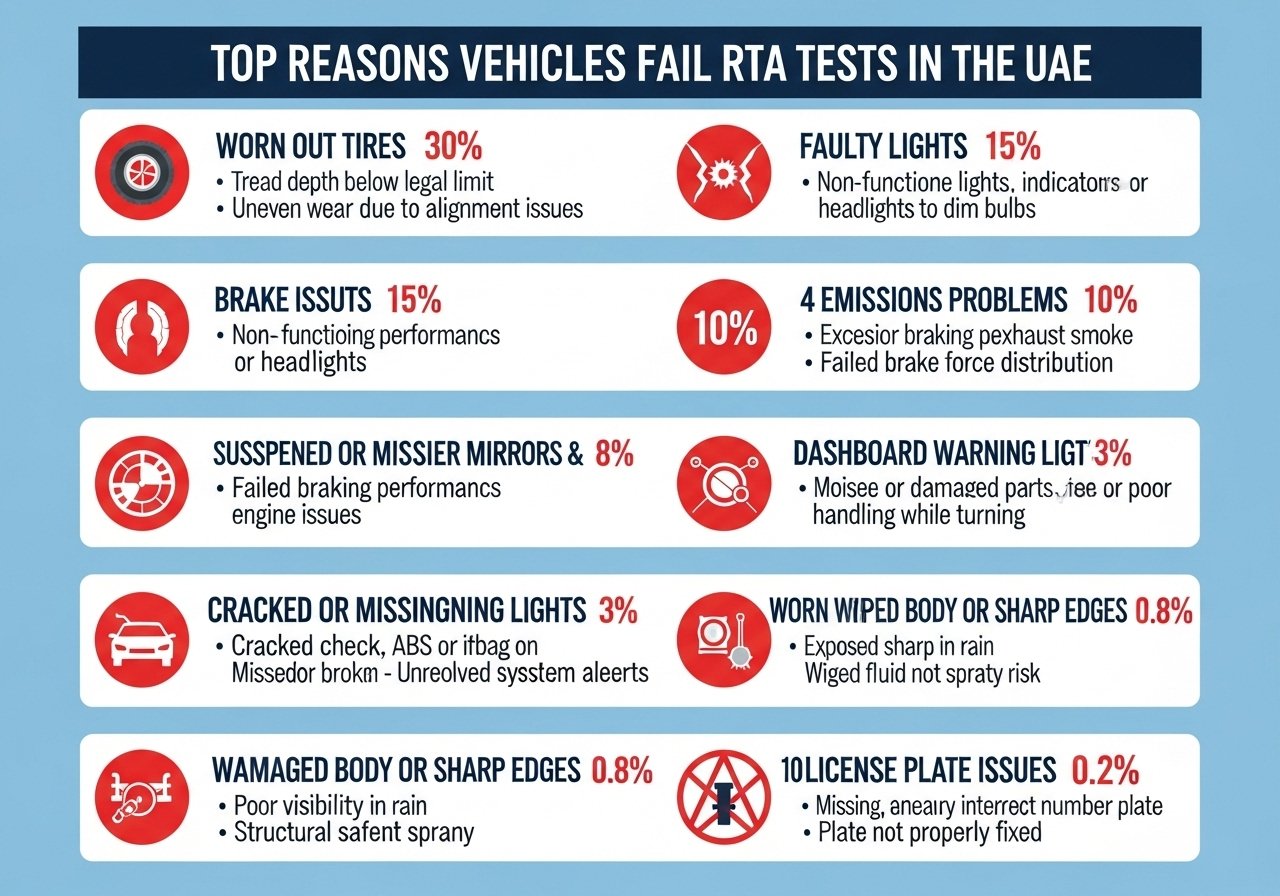It’s a moment of anxiety for many car owners in Dubai. You’ve dropped your car off for its annual technical test, and you’re waiting for that all-important SMS.
A “PASS” result means a year of worry-free driving. A “FAIL” result, however, means a frustrating cycle of repairs and re-tests.
Many drivers are surprised to learn that most failures are caused by simple, easily avoidable issues. Understanding these common pitfalls is the key to passing the first time.
This guide breaks down the top 10 most common RTA vehicle test failure reasons.
We provide simple tips to check your car beforehand, saving you time, money, and stress.
Being aware of these points is crucial for every car owner in Dubai.
Before the Test: A 5-Minute Pre-Check Can Save You a Trip
You don’t need to be a mechanic to spot potential problems. Before heading to a testing center like Tasjeel or Shamil, do this quick walkaround to avoid common RTA vehicle test failure reasons:
- Check All Lights: Have a friend help you check every exterior light—headlights (high and low beam), brake lights (all three), indicators, reverse lights, and even the license plate light.
- Test the Horn: A simple but essential safety feature.
- Look for Leaks: Check the spot where you usually park for any fresh puddles of oil, coolant, or other fluids.
- Clean Your Car: A clean car gives a better impression and makes it easier for inspectors to do their job.
The Top 10 RTA Vehicle Test Failure Reasons in Detail
Here are the most common issues that inspectors look for, and how to make sure your car is ready. Many of these RTA vehicle test failure reasons can be addressed before you even go to the testing center.
1. Worn, Damaged, or Expired Tires
The Problem: This is arguably the number one failure reason. Inspectors check for tread depth, visible cracks on the sidewall, and the tire’s manufacturing date.
Why It Fails: Worn tires are a massive safety hazard, severely reducing grip. This is one of the most serious RTA vehicle test failure reasons.
How to Avoid It: Check the four-digit date code on your tires (e.g., “3523” means the 35th week of 2023). Tires older than 5 years will likely fail, regardless of tread. Ensure the tread is sufficient and there are no visible bulges or cracks.
2. Faulty Lights
The Problem: A single non-functioning bulb is an instant fail. This includes headlights, brake lights, indicators, reverse lights, and even the small bulb illuminating the rear license plate.
Why It Fails: Proper lighting is critical for you to see and for other drivers to see you.
How to Avoid It: This is the easiest check to do at home. Replace any burnt-out bulbs before the test—it’s a cheap and simple fix to avoid one of the simplest RTA vehicle test failure reasons.
3. Illegal Window Tint
The Problem: The tint on your car’s windows is too dark or is applied to the front windscreen.
Why It Fails: According to the RTA, window tint cannot exceed 50% on the side and rear windows. Any tint on the front windscreen is prohibited.
How to Avoid It: If you’re unsure, visit a reputable tinting shop to have it measured or removed before the test. This is a very common issue among all RTA vehicle test failure reasons.
4. Brake System Issues
The Problem: Worn brake pads, low brake fluid, or an imbalance in the braking force between wheels.
Why It Fails: The brakes are your car’s most important safety feature. Any inefficiency is a major risk.
How to Avoid It: If you hear any squeaking or grinding noises when you brake, or if the car pulls to one side, get your brakes checked by a professional before the RTA test.
5. Steering and Suspension Problems
The Problem: Worn-out components like tie rods, ball joints, or leaking shock absorbers.
Why It Fails: A loose or failing suspension system can compromise the car’s stability and handling.
How to Avoid It: Listen for clunking noises when going over bumps and feel for excessive vibration in the steering wheel. These are signs that your suspension needs attention.
6. Excessive Exhaust Smoke or Noise
The Problem: The car emits visible smoke (blue, black, or white) or the exhaust is excessively loud.
Why It Fails: This indicates an engine or exhaust system problem, and it violates environmental standards. It’s one of the clearer RTA vehicle test failure reasons.
How to Avoid It: Visible smoke is a sign of a problem that needs a mechanic. A loud noise often means a hole in the muffler, which is a relatively straightforward repair.
7. Oil or Fluid Leaks
The Problem: Any active leak of engine oil, transmission fluid, coolant, or brake fluid.
Why It Fails: Leaks are a fire hazard and an environmental concern. They also indicate a part is failing.
How to Avoid It: Regularly check the ground under your car after it has been parked for a while.
8. Obstructed Driver’s View
The Problem: Cracks in the windshield, stickers, or phone mounts placed in the driver’s direct line of sight.
Why It Fails: Anything that obstructs the driver’s clear view of the road is a safety violation.
How to Avoid It: Repair any significant windshield cracks before the test and remove any items from the windscreen.
9. Chassis and Frame Damage
The Problem: Evidence of major, poorly repaired accident damage or significant rust on the car’s underlying frame.
Why It Fails: A compromised chassis can affect the car’s structural integrity in a future accident. Many buyers are unaware of these potential RTA vehicle test failure reasons.
How to Avoid It: This is harder for a non-expert to spot, but it’s a key reason to buy from a reputable source that performs checks for major accidents.
10. Missing or Non-Functioning Essential Items
The Problem: A horn that doesn’t work, a missing side mirror, or damaged windscreen wipers.
Why It Fails: These are all considered essential safety components.
How to Avoid It: Do a quick check of these basic functions before you go.
The Easiest Way to Guarantee a Pass
The stress of the RTA test is real, especially with an older car. The simplest way to avoid this annual anxiety is to start with a car that’s guaranteed to pass.
At Arabity Online, every certified vehicle undergoes a comprehensive, RTA-compliant inspection *before* it’s even listed for sale. We fix any potential issues so you can buy with the confidence of a guaranteed pass and no surprises from these RTA vehicle test failure reasons.
Frequently Asked Questions (FAQ)
Do minor scratches or dents cause an RTA test failure?
Generally, no. Minor cosmetic issues like scratches and small dents do not typically cause a failure. The test is focused on the safety and roadworthiness of the vehicle.
However, large dents with sharp edges or damage that affects a door’s ability to open and close properly can be among the RTA vehicle test failure reasons.
How much does a re-test cost if my car fails?
If you fix the issues and bring the car back for a re-test within the 30-day grace period, the re-test fee is significantly lower, usually around AED 75.
If you miss this window, you will have to pay the full inspection fee again.
Can I test my car before the registration renewal date?
Yes, you can. It’s actually a smart idea to get the vehicle tested a week or two before your renewal is due. This gives you plenty of time to fix any potential issues without the stress of an expiring registration.
Conclusion: Pass with Preparation
As you can see, most RTA vehicle test failure reasons are related to basic maintenance and wear-and-tear.
By taking an hour to perform a simple pre-check of your car’s lights, tires, and basic functions, you can save yourself the time and expense of a failed test.
Being aware of these RTA vehicle test failure reasons is the first step to success. Drive safe, and good luck!





